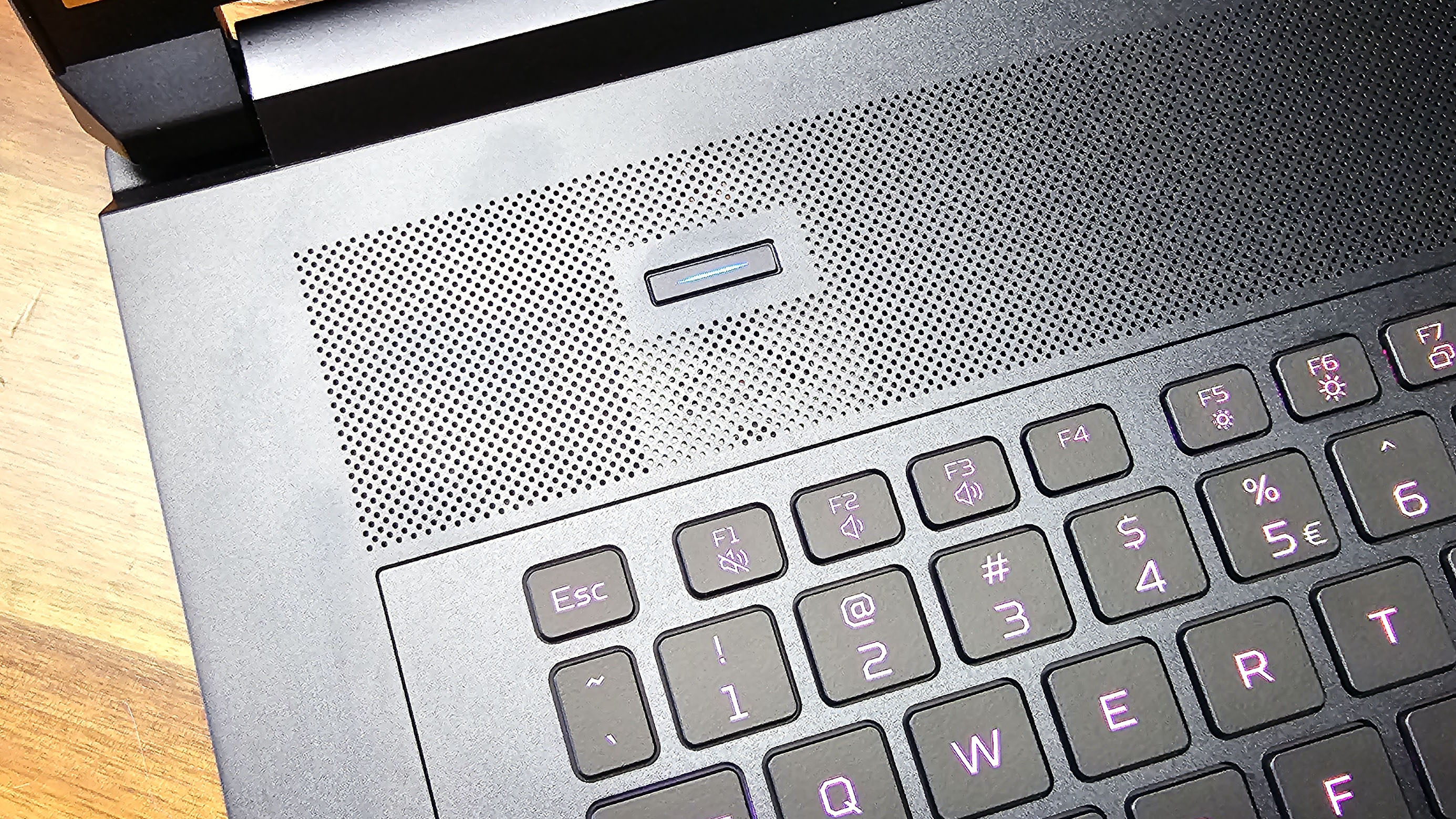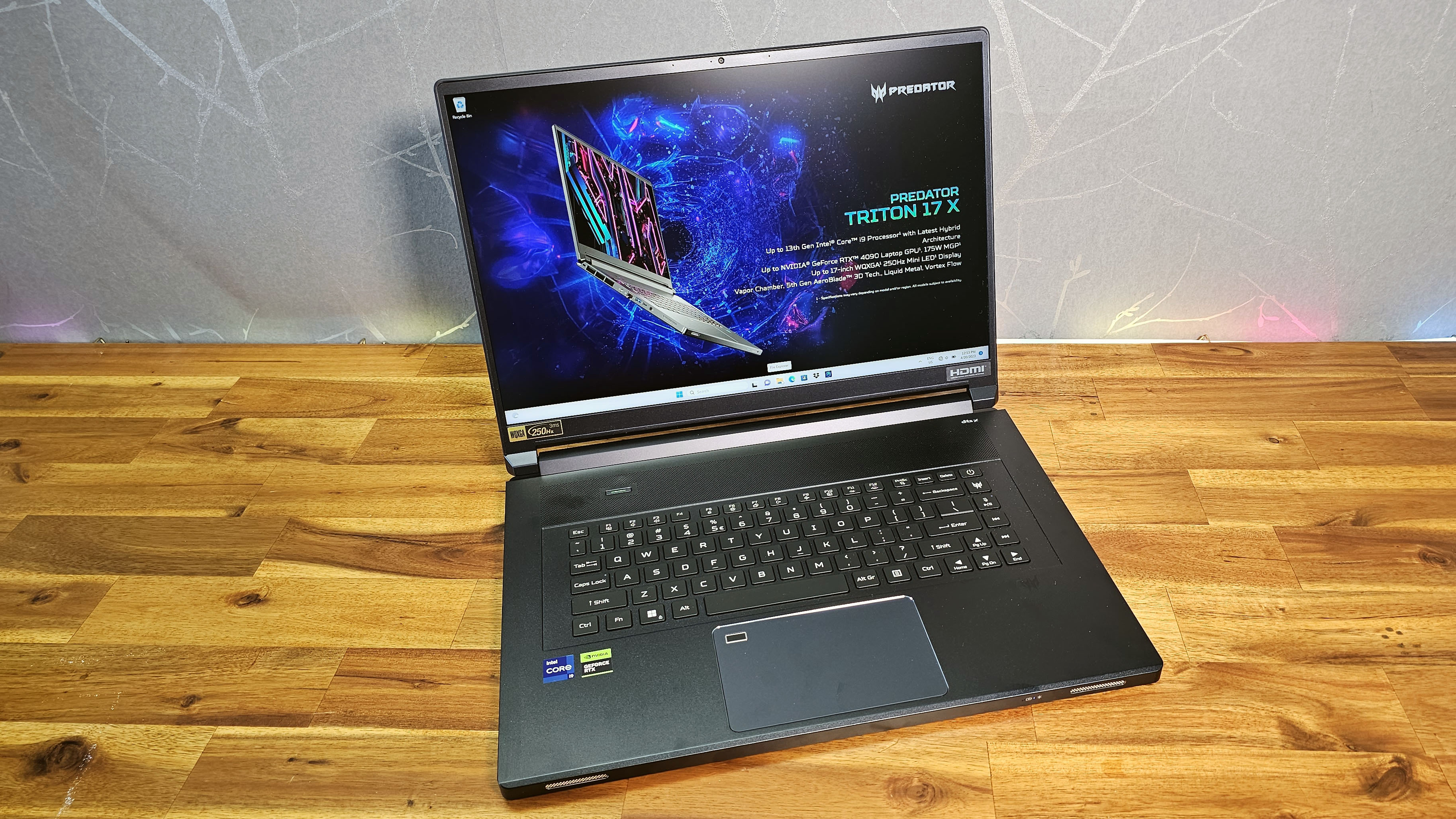Hands-On: Acer's Blade-Like Predator Triton 17 X Takes Clear Aim at Razer
A slim metal shell and a Mini-LED display meets an RTX 4090 for an understated but powerful Predator portable.
Acer's Predator gaming lineup has embraced some pretty aggressive designs over the years, but its latest Triton 17 X looks a lot more like a Razer Blade than I would have expected from a Predator-branded PC – and that's a good thing.
Acer sent us a pre-production model of the Predator Triton 17 X, which means we can't benchmark it yet or dissect its innards because performance, finish and / or components might not be in line with final shipping units. But from what I can see on the outside, I'm quite impressed. At about the same thickness as the Blade 16 (Acer claims 0.86 inches to the 0.87-inch Blade 16, although putting the two side-by-side, the Acer is slightly thicker at the back) and 6.61 pounds, this is far from a bulky laptop given that it supports up to an RTX 4090 and a Core i9-13900HX (both included in our unit).
But the design also stands out for its all-metal, all-black shell that reminds me of Razer's Blade laptops, save for some extra cutouts for cooling vents around the sides and back of the device.


For those who like a bit of color, the keyboard is RGB, and there's a small Predator head logo below the lower-right corner of the keyboard that's also RGB-backlit. It's flush with the keyboard deck, looks like it's made up of tiny pixels, and looks cooler than it has any right to. There's also a narrow RGB-lit button above the keyboard, on the left, which I at first thought was the power switch (until it didn't work several times, even after plugging the laptop in. The power button is on the top right of the keyboard).
This is actually for shifting between power profiles, which might come in handy for those times when you just want to jump into eco mode to browse the web or watch a movie without lots of fan noise. But mostly it seems an unnecessary addition given that most people aren't likely to change power modes often, and those that want to can do so via Acer's software.
The other key standout on the Predator Triton 17 X is the Mini-LED display. Several makers of high-end laptops have jumped into the Mini-LED realm this generation (and MSI's Titan GT77 HX is still the best of those we've tested so far). But with a promised 100% of the DCI-P3 color space and 1,000 nits of brightness, Acer's panel here looks great on paper. It also looks very good to my eyes, with extreme blacks and vivid colors as I watched (for about the thirtieth time) the John Wick 4 trailer.
We'll have to get a final review unit and do our usual display testing to say for sure how it stacks up against the Titan, Razer Mini-LED-packing Blade 16, and other high-end gaming laptop displays. But if you're hoping for high resolutions, note that the Triton 17 X tops out at 2560 x 1600 (and 250 Hz). There's also an option for a 400-nit 240 Hz IPS display that, presumably, will cost quite a bit less. And it's easy to share that screen with others, as the laptop's hinge opens a full 180 degrees, which I wasn't expecting.
As someone who does more than just gaming and has lots of peripherals, I like the Triton 17's ample connectivity – which also echoes the Blade laptops. The left edge houses the barrel connector for the large power brick (necessary when we're dealing with an RTX 4090), a 2.5 Gb Ethernet jack (Wi-Fi 6E is also included), USB-A (3.2 Gen 2), Thunderbolt 4 (USB-C) and a headset audio jack.
Get Tom's Hardware's best news and in-depth reviews, straight to your inbox.
The right edge delivers a full-size HDMI 2.1 port, an SD card slot, and another pairing of USB-A and Thunderbolt Type-C ports.
One thing that I was less impressed by on the Triton 17 X was the audio output. Acer says there are six speakers here, and there are four silver grilles around the edges of the laptop, as well as a large mesh area above the keyboard. But at least with our unit, while the volume got impressively loud, when I listened to my favorite test track, Buck-Tick's classic "Muma - The Nightmare," there was very little bass and Atsushi Sakurai's vocals were very forward in the mix and harsh. I thought this might be an issue with the sound being optimized for gaming. But when I fired up the included DTX software, the Music preset was selected.
Regardless, as this is a pre-production unit, we'll have to wait for a final model and a full review to pass full judgment on the audio. The 1080p webcam, however, was bright, crisp and color accurate for me in my sunlit living room. But when I turned so that the windows were behind me, the image had a tendency to wash out and get soft. Again, we'll need to test a final unit, but it is nice to see a 1080p webcam included on a gaming laptop.
We're eager to see how a final version of the Triton 17 X performs in our testing, as well as how the battery holds up. But with a large 99.8 WHr battery and Nvidia's Advanced Optimus (for switching between the GPU and Intel's integrated graphics), the laptop does have a lot going for it. In the end, it's going to come down to how much power the 1,000-nit Mini-LED display draws. And of course we can't wait to test how well the screen stacks up to the increasing Mini-LED competition in testing, too.
But if the performance lands in line with what we'd expect for the hardware, Acer's Predator Triton 17 X could be one of its most appealing gaming laptops in years – especially if you like the looks of Razer's competing laptops and Acer can undercut the Blades in price. At the moment, we know that the Triton 17 X will start selling in May at $3,799. It will follow in Europe and other territories in June beginning at €4,499.
MORE: How to Buy a Gaming Laptop
MORE: Best Gaming PCs
After a rough start with the Mattel Aquarius as a child, Matt built his first PC in the late 1990s and ventured into mild PC modding in the early 2000s. He’s spent the last 15 years covering emerging technology for Smithsonian, Popular Science, and Consumer Reports, while testing components and PCs for Computer Shopper, PCMag and Digital Trends.
-
pixelpusher220 17" desktop replacement with no number pad and a silly 1980s turbo button. Back to the design board peepsReply







